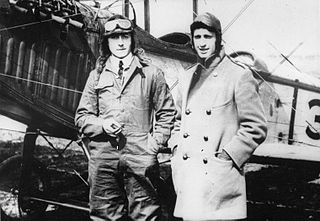Related Research Articles
Captain James Butler White, DFC, RNAS was a World War I Royal Naval Air Service flying ace.

Arthur Treloar Whealy DSC & Bar DFC was a Canadian First World War flying ace, officially credited with 27 victories.
Paul Billik was a German World War I fighter ace credited with 31 victories. He was killed in a flying accident while pioneering civil aviation.
Captain Thomas Frederic Williams MC was a Canadian First World War flying ace, officially credited with 14 victories.

Captain Ernest Charles Hoy DFC was a Canadian First World War flying ace, officially credited with 13 victories. He later pioneered airmail flight over the Canadian Rockies.
Captain Hazel LeRoy Wallace DFC was a Canadian First World War flying ace, officially credited with 14 victories. His record shows him to have been a notable team player in squadron tactics.
Captain George Edwin Thomson DSO MC was a Scottish World War I flying ace credited with 21 aerial victories. He was the second ranking ace of his squadron, and one of the leading Sopwith Camel aces.
Lieutenant Lionel Arthur Ashfield DFC was a World War I British flying ace credited with seven aerial victories.
Second Lieutenant John Bernard Russell was a World War I flying ace credited with five aerial victories.
Captain Ronald Sykes (1899-1977) was a World War I flying ace credited with six aerial victories.
Captain Frank Clifton Gorringe was a British World War I flying ace credited with 14 aerial victories.
Herbert Gilles Watson, was an Australian flying ace of the First World War credited with 14 aerial victories. He was the highest scoring New Zealand-born ace in the Australian Flying Corps, and the fourth highest scorer in his squadron.
Captain William Henry Hubbard DFC was a Canadian World War I flying ace credited with twelve aerial victories against enemy fighter planes despite spending a year and a half out of action. He was noted for his zeal in ground support missions, as well as his success against enemy fighters.
Captain Alexander Beck was an Anglo-Argentine aviator during World War I. He was an underage enlistee who went on to become a flying ace credited with 11 official aerial victories.
Fred Everest Banbury, was a Canadian flying ace of the First World War, officially credited with eleven aerial victories while serving in the British Royal Naval Air Service.
Major John Charles Bradley Firth was a British World War I flying ace credited with 11 aerial victories while campaigning on the Italian Front.
Richard Jeffries Dawes DFC was a Canadian World War I flying ace credited with nine aerial victories.
Lieutenant William Benson Craig was a Canadian flying ace during World War I. He was credited with eight aerial victories over German fighter planes.
Merrill Samuel Taylor was a Canadian flying ace of the First World War. He was credited with seven aerial victories while flying a Sopwith Camel fighter for the Royal Naval Air Service and, later, the Royal Air Force. He touched off the air battle that resulted in the death of the war's leading ace, Manfred von Richthofen, on 21 April 1918. On 2 May 1918, he killed German ace Hans Weiss for his fifth victory. Taylor was killed in action by Franz Büchner on 7 July 1918.

Captain William John MacKenzie was an American flying ace who served with British naval aviation during World War I. He was one of the combatants in Manfred von Richthofen's last fight, being wounded in action. He was awarded the Distinguished Flying Cross, and the Croix de Guerre for his valor. He survived the war and was discharged in 1919. His history after 1942 is unknown.
References
- Shores, Christopher, et al. (1990). Above the Trenches: A Complete Record of the Fighter Aces and Units of the British Empire Air Forces, 1915-1920. Fortress Publications. ISBN 0-91919-511-3 ISBN 978-0-91919-511-0